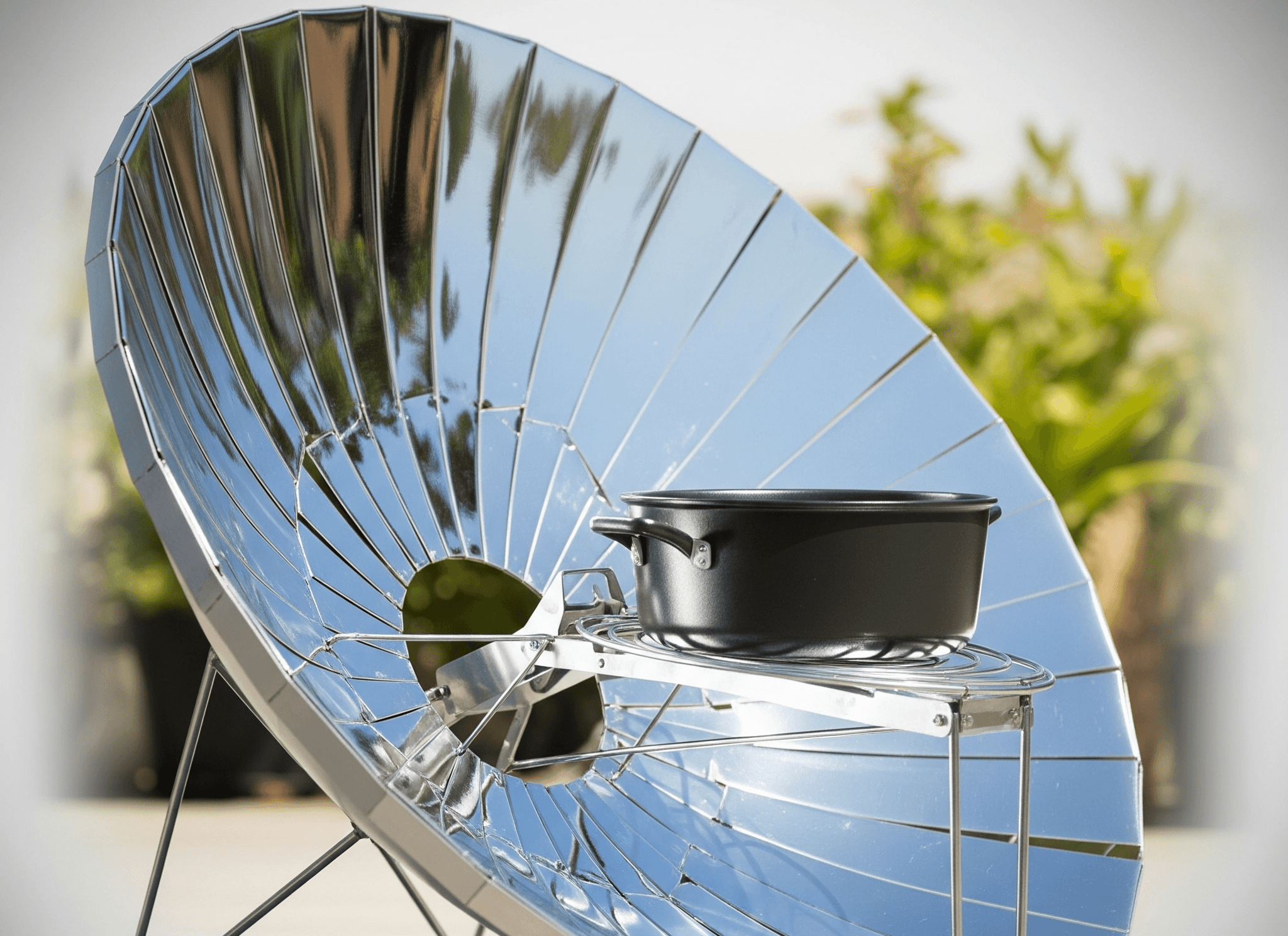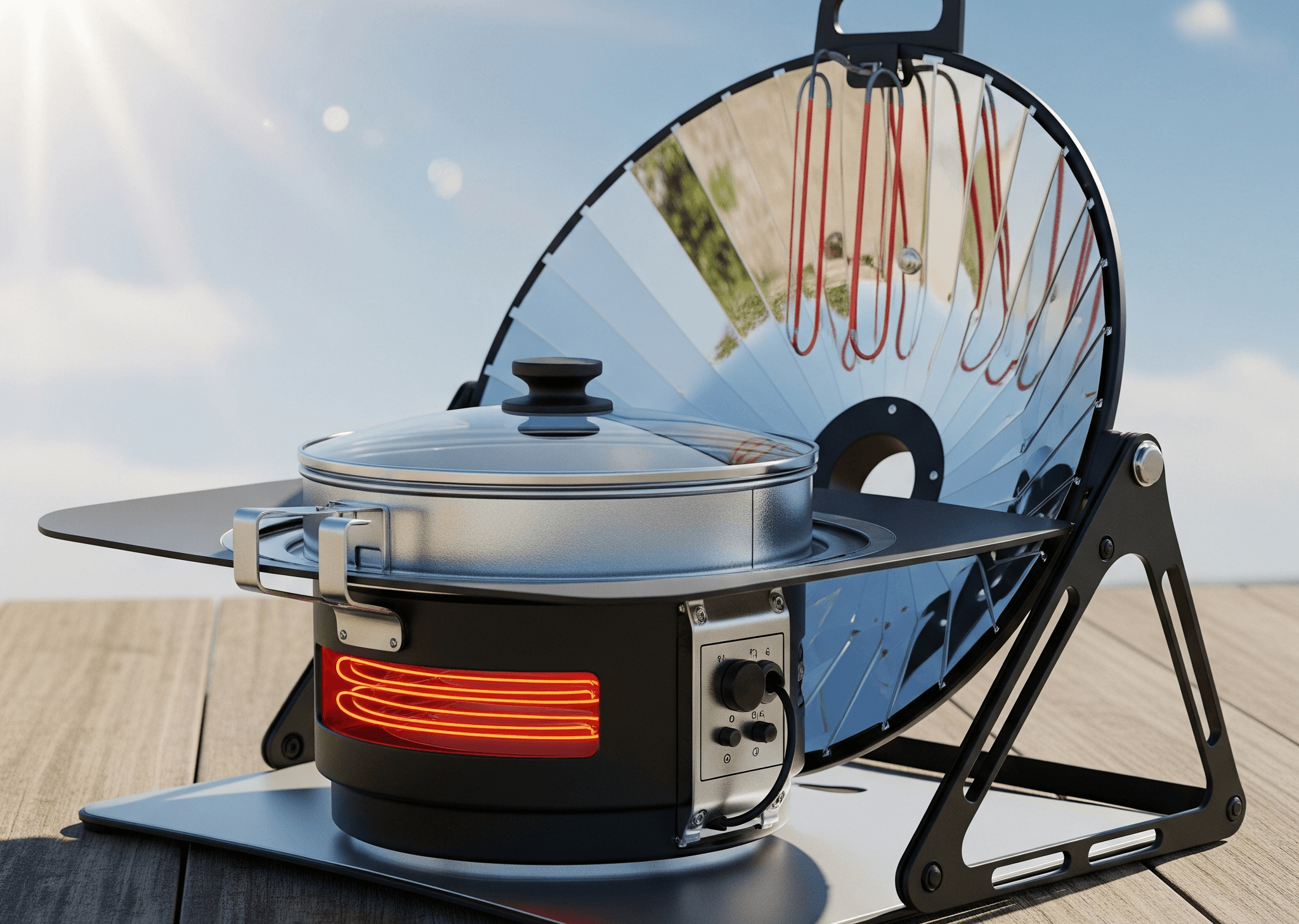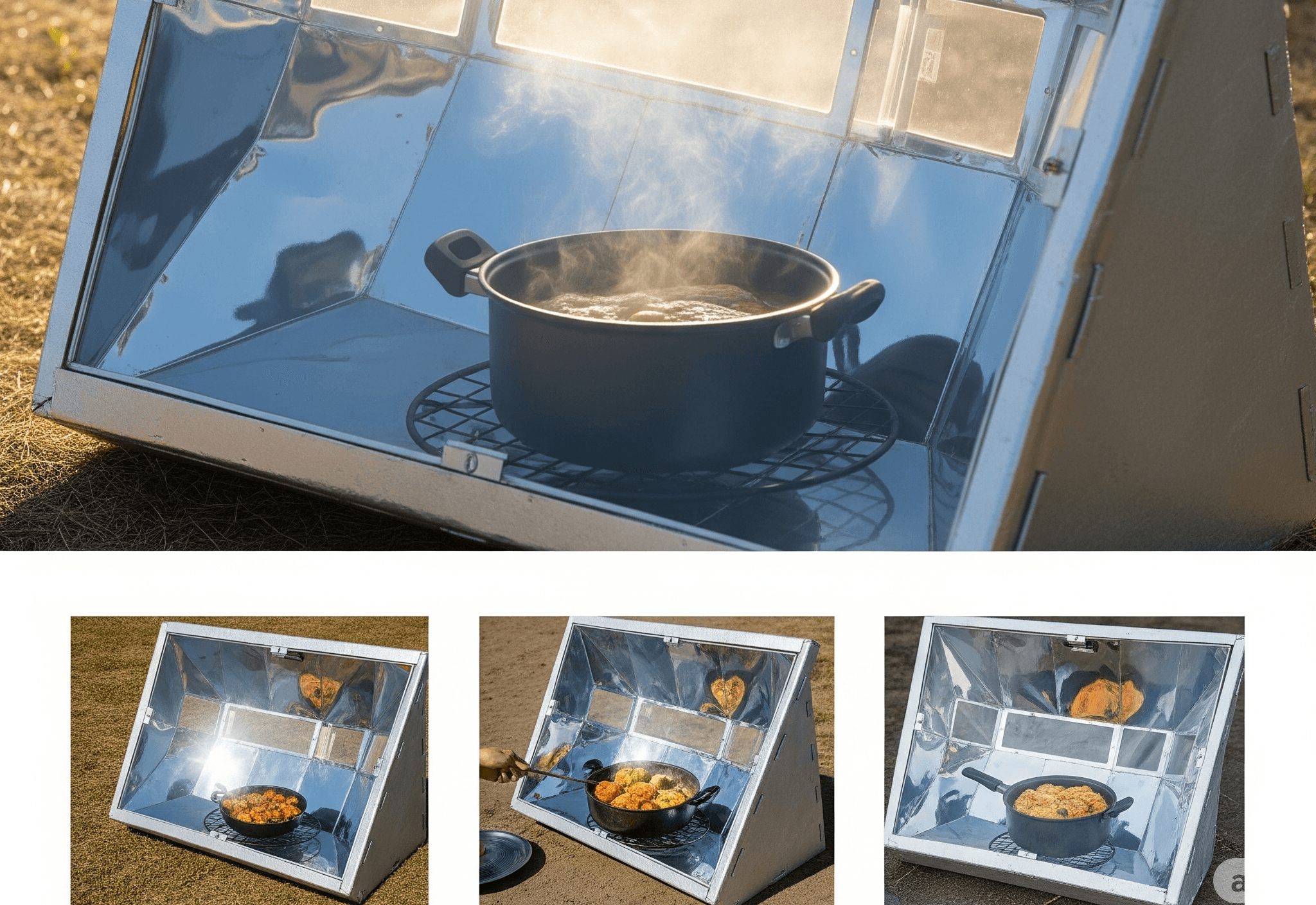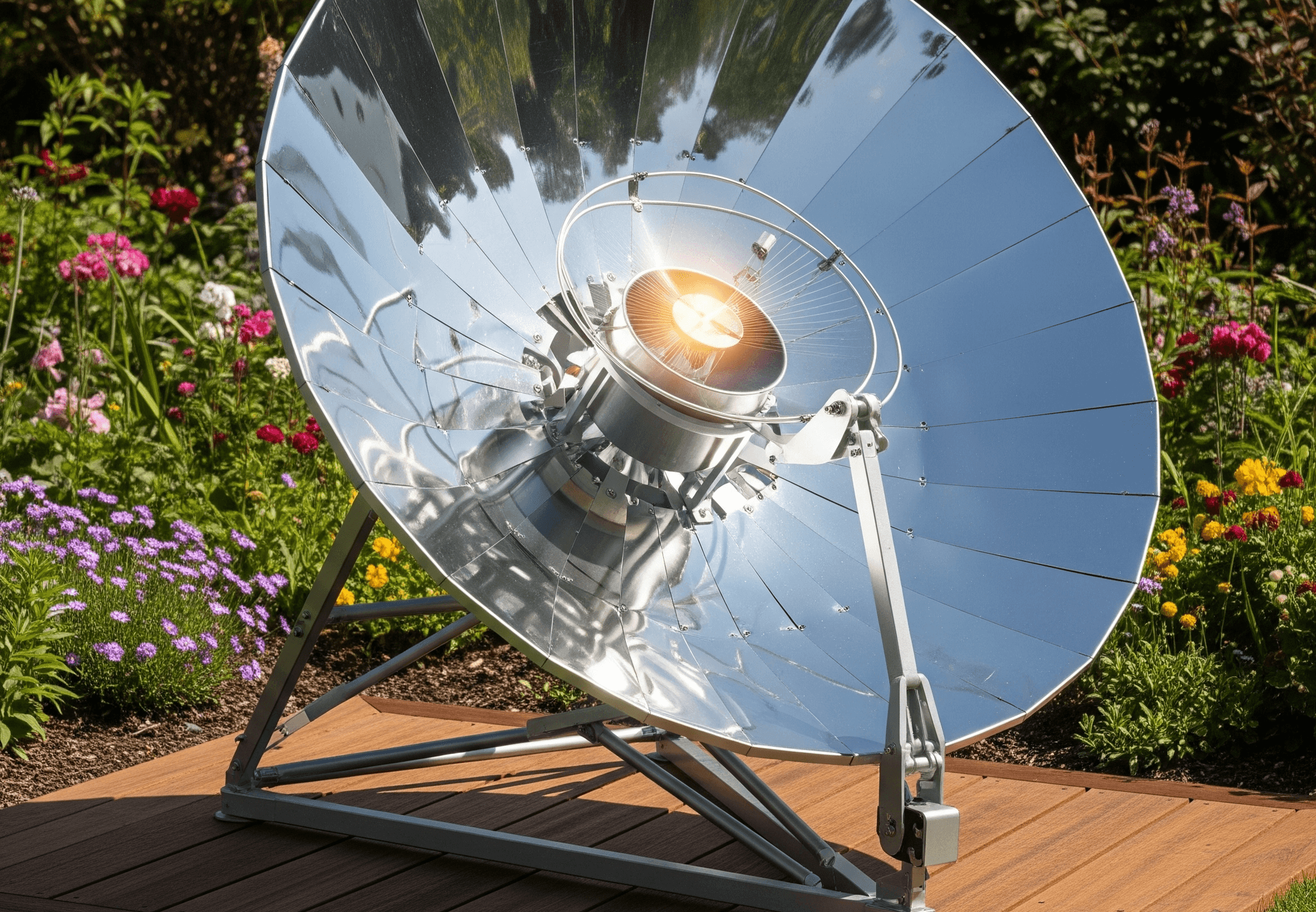Solar Cookers
Importance:
- Cooking consumes a major portion of energy—about 64% in rural areas of India.
- Traditional energy sources for cooking include firewood, crop residues, and animal dung cakes.
- Collecting firewood is labor-intensive, mostly done by women who walk long distances carrying heavy loads.
- Forest depletion is increasing due to firewood demand.
Health & Environmental Concerns:
- Burning firewood and dung causes smoke-related health hazards, especially for women.
- Solar cookers reduce the use of firewood and fossil fuels, leading to cleaner cooking environments.
- They help save LPG, kerosene, and electricity in urban areas.
Limitations:
- Solar cookers cannot fulfill all cooking needs for all sections of society.
- Acceptance depends on adapting to traditional cooking patterns (e.g., large meals cooked outside sunshine hours).
- There is scope for improving thermal efficiency and developing hybrid solar cookers that can be used during cloudy or off-sunshine hours.
Environmental and Social Benefits
- Annually in India:
- 150 million tons of firewood,
- 52 million tons of dried dung, and
- 36 million tons of agricultural waste are used for cooking.
- These non-commercial fuels contribute about 45% of the total energy supply.
- Solar cookers can reduce deforestation and reliance on dung cakes for fuel.
Advantages of Solar Cookers
- Can cook multiple items simultaneously (e.g., 4-pot cookers).
- Preserves nutritional value of food.
- Requires no constant attention during cooking.
- Eliminates risk of fire accidents and overcooking.
- Pollution-free, keeps kitchen and utensils clean.
- Useful for baking and roasting (except chapattis).
- Saves firewood and commercial fuels.
- Saves money and time.
- No recurring fuel or maintenance cost.
- Easy to manufacture, use, and maintain.
- Use can extend the life of gas cylinders.
Disadvantages of Solar Cookers
- Takes longer time to cook compared to conventional methods.
- Cannot substitute for all types of cooking (e.g., frying, chapattis).
- Requires additional mechanisms for use on cloudy days or at night.
Types of Solar Cookers

- Box Type Solar Cooker (Hot Box Type)
- Uses solar heat without concentrating sunlight.
- Suitable for cooking rice, dal, vegetables, meat, snacks, desserts, etc.
- Cannot fry or bake chapattis (needs higher temperature).
- Typical size: around 60 cm × 60 cm with 4 pots.
- Cost ranges from Rs. 1800 to Rs. 3000.
- Components include outer/inner boxes, thermal insulation, double glass cover, mirror, cooking containers with absorber paint.
- Concentrating Type Solar Cooker

- Concentrates sunlight from a large surface to a smaller area to achieve higher temperatures.
- Useful for applications needing high heat.
- Hybrid Solar Cookers

- Combine solar cooking with electrical or thermal storage backup for use during off-sunshine hours or cloudy days.
- Can be called solar ovens when electrical backup is included.
- New Designs for Flats and Urban Use
- Cookers that bring sunlight into the kitchen through windows or south-facing walls.
- Stationary systems integrated into buildings.
- Allows cooking inside without going outside in the sun.
- Suitable for pressure cookers and faster cooking.
- Window Type Solar Cookers

- Designed for kitchens with south-facing windows.
- Often include electrical backup.
- Solar Steam Cooking Systems
- Use solar concentrators to generate high-pressure steam for large-scale cooking.
- Example: Tirumala Tirupathi Devasthanam (TTD) solar steam system cooks for 15,000 people/day.
- Uses automatic tracking parabolic dish concentrators.
- System is supported by diesel boiler backup for reliability.
Dish Type Solar Cookers

- Usage: Outdoor cooking for 10-15 people; suitable for homes and small establishments.
- Design: Uses a parabolic dish (also called SK-14 type) to concentrate solar radiation.
- Performance:
- Power output ≈ 0.6 kW on sunny days.
- Can boil 2-3 liters of water in about 30 minutes.
- Vessel bottom temperature: 350-500ºC.
- Cost: Rs. 5500 to Rs. 7000 depending on reflector type.
- Savings: Can save up to 10 LPG cylinders per year with full use.
- Incentives: MNRE subsidy up to 30% of cost (max Rs. 1500).
Concentrating Solar Cooker (Solar Oven)
- Used for quick cooking by concentrating solar radiation.
- Example calculation shows the required area of solar oven for 200W heat with 20% efficiency and solar insolation of 800 W/m² is 1.25 m².
- Doubling efficiency to 40% halves the required area to 0.625 m².
Community Solar Cookers (Scheffler Cooker)
- Larger parabolic reflector (7 to 12 m² aperture area).
- Can cook for 40-50 people, cooking time per dish 60-90 minutes.
- Has a mechanical clockwork system to track the sun automatically.
- Suitable for schools, hospitals, canteens, etc.
- Cost ~ Rs. 50,000; payback period of 4-5 years.
Material Problems
- Problems relate to outer/inner boxes, insulation, rubber strips, black paint.
- Need better transparent covers with high transmissivity and low heat loss.
- Using better insulation like polyurethane can improve performance.
Efficiency of Solar Cookers
- Ordinary black paint: 20-25% efficiency.
- Selective coating: ~30%.
- Nickel-black coating: 50-60%.
- Anti-reflective coatings can improve efficiency by 8-10%.
Heat Transfer in Solar Cookers
- Cooking involves conduction, convection, and sometimes radiation.
- Water is commonly used as a heat transfer medium (boiling point limit 100°C).
- Higher cooking temperature = faster cooking.
- Preheating cooker for 45 min in sunlight reduces cooking time.
- Pressure cookers with blackened aluminum bottom work better in solar cookers.
Power Ratings of Solar Cookers
|
Cooking Device |
Power Rating |
|
LPG Stove |
6 kW |
|
Biogas Stove |
2 kW |
|
Electric Heater |
1 kW |
|
Solar Cooker |
0.5 kW |
- Solar cookers have the lowest power rating but can improve with better design.
Usage Tips
- Add exact water quantity; do not exceed half pot level.
- Cut vegetables into small pieces.
- Soak raw ingredients before cooking.
- Cover containers to retain nutrients and heat (except baking).
- Use gloves or cloth to handle hot containers.
- Clean cooker and pots regularly; maintain black surfaces.
Summary
- Solar cookers reduce firewood use and environmental degradation.
- Useful in rural and urban sectors, including institutions.
- Advantages: multiple dishes at once, nutrient preservation, no fire hazard, pollution-free.
- Disadvantages: longer cooking time, limited use on cloudy days.
- Types: box type (little/no concentration) and concentrating type.
- Hybrid designs (electricity + thermal storage) can enable night cooking.
- New designs for kitchens with south-facing windows may enhance usability.
- Solar steam cooking systems for community kitchens use solar concentration.

